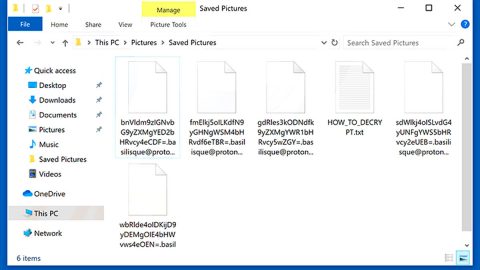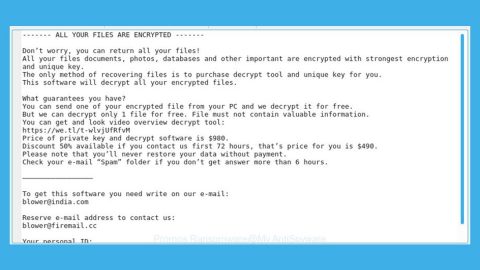What is Mr. Dec ransomware? And how does it carry out its attack?
Mr. Dec ransomware is crypto-malware that has been discovered in a small attack campaign. This crypto-malware appears to be newly-developed and does not originate from any well-known ransomware group. Based on the analysis conducted by security experts from the captured samples of this ransomware, it seems that the ransomware is a test version or initial builds. In other words, the initial features you can usually notice in a typical ransomware threat are not yet integrated. However, if its first attacks are proven to be effective and successful, future versions of this threat might likely be developed.
Once it enters a system, Mr. Dec ransomware carries out its attack with an information gathering engine where it is programmed to gather several types of strings in advance. The campaign metrics gathered are then used to optimize its attacks by registering the installed hardware components as well as certain operating system strings. The information gathering engine can also be used to harvest personally identifiable information about the users which could expose their identities. The personally identifiable information gathered includes name, address, telephone or mobile number, account credentials, passwords and more. The information harvested can be processed by a stealth protection module that protects the malicious executable file of this crypto-virus from any program that could interfere with its attack.
Moreover, Mr. Dec ransomware is also programmed to modify the Windows Registry so it can achieve persistence. This means that the ransomware can automatically start in every system boot. After it achieves persistence, it will begin its encryption attack using the AES encryption algorithm. It mostly targets user-generated data like documents, database, images, videos, audio files and many more. And instead of using a generic rename template, Mr. Dec ransomware appends a random extension that goes like this “.[ID][ID]”. After the encryption, a file named “Decoding help.hta” is generated which contains the ransom note stating:
“You are unlucky! The terrible virus has captured your files! For decoding please contact by email
[email protected] or
[email protected]
Your
ID ***** ID
- In the subject line, write your ID.
- Attach 1-2 infected files that do not contain important information (less than 2 mb)
- Attach the file to the location c:\Windows\DECODE KEY.KEY
are required to generate the decoder and restore the test file.
Hurry up! Time is limited!
Attention!!!
At the end of this time, the private key for generating the decoder will be destroyed. Files will not be restored!
0·1·19·28”
If you are one of the few victims of this ransomware threat, the best thing you can do is to wipe it out from your system instead of giving in to its whims.
How does Mr. Dec ransomware spread online?
Mr. Dec ransomware most likely spreads via spam emails. Thus, you need to be cautious in opening suspicious-looking emails as well as download software or a software update from third-party sources.
To successfully wipe out Mr. Dec ransomware from your computer, make sure to follow each one of the removal steps below.
Step 1: The first thing you have to do is to close the GUI window of Mr. Dec ransomware. If you’re not able to close it manually, you can do so by tapping Ctrl + Shift + Esc keys to launch the Task Manager.
Step 2: Go to Processes and look for the malicious process of Mr. Dec ransomware then right click on it and select End Process or End Task.

Step 3: Close the Task Manager and open Control Panel by pressing the Windows key + R, then type in appwiz.cpl and then click OK or press Enter.
Step 4: Look for dubious programs that might be related to Mr. Dec ransomware and then Uninstall it/them.

Step 5: Tap Win + E to launch File Explorer.
Step 6: From there, navigate to the following directories listed below and look for the malicious components of Mr. Dec ransomware like Decoding help.hta and remove them all.
- %TEMP%
- %APPDATA%
- %DESKTOP%
- %USERPROFILE%\Downloads
- C:\ProgramData\local\
Step 7: Close the File Explorer.
Before you proceed to the next steps below, make sure that you are tech savvy enough to the point where you know exactly how to use and navigate your computer’s Registry. Keep in mind that any changes you make will highly impact your computer. To save you the trouble and time, you can just use [product-name], this system tool is proven to be safe and excellent enough that hackers won’t be able to hack into it. But if you can manage Windows Registry well, then, by all means, go on to the next steps.
Step 8: Tap Win + R to open Run and then type in regedit in the field and tap enter to pull up Windows Registry.

Step 9: Navigate to the listed paths below and look for the registry keys and sub-keys created by Mr. Dec ransomware.
- HKEY_CURRENT_USER\Control Panel\Desktop\
- HKEY_USERS\.DEFAULT\Control Panel\Desktop\
- HKEY_LOCAL_MACHINE\Software\Microsoft\Windows\CurrentVersion\Run
- HKEY_CURRENT_USER\Software\Microsoft\Windows\CurrentVersion\Run
- HKEY_LOCAL_MACHINE\Software\Microsoft\Windows\CurrentVersion\RunOnce
- HKEY_CURRENT_USER\Software\Microsoft\Windows\CurrentVersion\RunOnce
Step 10: Delete the registry keys and sub-keys created by Mr. Dec ransomware.
Step 11: Close the Registry Editor.
Step 12: Empty your Recycle Bin.
Try to recover your encrypted files using the Volume Shadow copies
Restoring your encrypted files using Windows’ Previous Versions feature will only be effective if Mr. Dec ransomware hasn’t deleted the shadow copies of your files. But still, this is one of the best and free methods there is, so it’s definitely worth a shot.
To restore the encrypted file, right-click on it and select Properties, a new window will pop-up, then proceed to Previous Versions. It will load the file’s previous version before it was modified. After it loads, select any of the previous versions displayed on the list like the one in the illustration below. And then click the Restore button.

Complete the removal process of Mr. Dec ransomware by using a trusted and reliable program like [product-name]. Refer to the following guidelines on how to use it.
Perform a full system scan using [product-code]. To do so, follow these steps:
- Turn on your computer. If it’s already on, you have to reboot
- After that, the BIOS screen will be displayed, but if Windows pops up instead, reboot your computer and try again. Once you’re on the BIOS screen, repeat pressing F8, by doing so the Advanced Option shows up.

- To navigate the Advanced Option use the arrow keys and select Safe Mode with Networking then hit
- Windows will now load the SafeMode with Networking.
- Press and hold both R key and Windows key.
- If done correctly, the Windows Run Box will show up.
- Type in the URL address, [product-url] in the Run dialog box and then tap Enter or click OK.
- After that, it will download the program. Wait for the download to finish and then open the launcher to install the program.
- Once the installation process is completed, run [product-code] to perform a full system scan.















